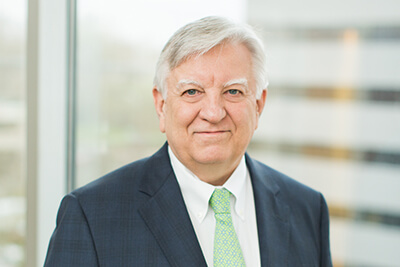As Doug experiences the delight of his 41st tax season, we asked him to take a look back at the last 40.
I started what became the Dean Dorton & Ford part of our firm in June 1979 (at age 30), following eight years with Coopers-Lybrand—now part of Pricewaterhousecoopers, known as PwC. My sole employee was Martha Jones, who at that time was not an accountant. Martha worked as administrative assistant, office bookkeeper, receptionist, typist (pre-document processing), billing, and whatever else was needed. As some may know, she later earned her accounting degree, became a CPA, and became a shareholder in the firm. Our office was in the old First National Building, now 21-C Hotel, in Lexington.
After starting the firm, it quickly became apparent that I needed more help. Richard Dorton, with whom I had worked at Coopers, joined me as an employee that December. Joe Ford, with whom Richard and I worked at Coopers, joined us as an employee in October 1980. Effective January 1, 1982, we incorporated as Dean Dorton & Ford, PSC. Several clients who started with me in that first year are still with the firm, either or all of themselves, family members, and family entities.
During these 40 years, our practice has evolved in many ways. From an informal partnership style in its early years to a much more corporate style with firm owners electing a board of directors and the board electing a CEO, firm governance has evolved to meet the needs of a growing organization.
Many major changes have occurred in the environment in which we operate. Following are just a few of them:
- Younger people in the firm likely cannot imagine the times before we had personal computers, cell phones, email, and software to track time and billing and to prepare spreadsheets. Documents were prepared on typewriters (no Microsoft Word), and fax machines (now almost obsolete) were a new tool for transmitting documents. Imagine preparing spreadsheets by hand and what was involved when one of the inputs in a financial analysis or projection had to be changed! Loan amortization schedules were computed using a calculator and prepared by hand!
- Business client accounting records were maintained in handwritten ledgers and journals.
- Business tax returns were prepared by hand, with the first pages being typed onto the forms and the rest of the handwritten pages being copied.
- Individual tax returns were prepared by computer, but on main-frame computers located at our vendor’s service center. Our tax preparers filled-out input sheets that were sent to the service center, where the data was key-punched, then printed returns were sent back to us. If any changes were needed before the returns were sent to our clients, the process was repeated.
- The business world has become much more complex, globalization has increased enormously, and tax laws have proliferated. Imagine a tax system which did not have passive activity rules, the net investment income tax, AMT, the qualified business income deduction, and significant changes at least every couple of years.
I sometimes wonder how many people we would need to produce the output of our services today without the technological advances of the last 40 years. I’d guess it would take at least twice as many tax staff members, possibly way more. And, many more support staff members would be needed. The pace of change seems to be accelerating, not slowing down, and I don’t believe any of us can predict what the next 10 (much less 40) years will look like.
Personally, the greatest work-related satisfaction I’ve gotten over the years has come from having played a role in helping clients solve problems and in identifying and implementing planning strategies. Usually, this has been done in conjunction with valued colleagues, and sometimes, I’m afraid, without doing a good job of making sure our client recognizes what has been accomplished. I’ve gained just as much satisfaction from believing I’ve played a meaningful role in the growth of several colleagues as they’ve developed into outstanding professionals and firm leaders.
Among the main things I’ve really liked from my chosen career, especially over the last 40 years, are:
- I’ve had the opportunity to play a key role in developing a sustainable business.
- Whether involving the firm as a whole, an industry group, a practice area group, or another group within the firm, I’ve enjoyed the opportunity to lead groups.
- Hardly, if ever, does a week or sometimes a day go by without exposing me to something new, and I embrace the challenges this presents.
- Whether colleagues, clients, or other professionals, I’ve enjoyed working with and getting to know a lot of different people.
- It has been important to me to work in an environment where colleagues at all levels are treated respectfully and courteously and where good performance is recognized and rewarded.
Although I’ve been in what must be one of the longest-term retirement transitions ever, I continue to enjoy the work I’m still doing (most days!) and the relationships with clients and colleagues. So, I’m hopeful the firm will allow me to continue a while longer.
